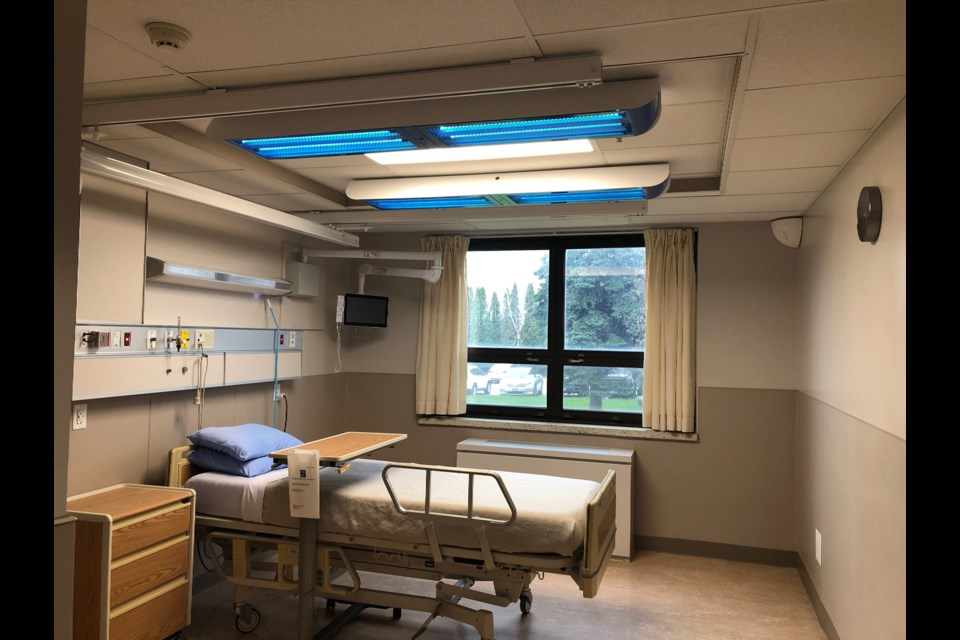There’s copper in them there walls.
Collingwood General and Marine Hospital (CGMH) has opened the first of five self-sanitizing rooms, and will be the first hospital in Canada to use copper-infused panels on the walls in its hallways and patient rooms to prevent bacteria growth.
Copper is naturally anti-bacterial and copper surfaces prevent bacteria growth.
The made-over patient room is located on the medical floor, and it’s packed with the latest technology in sanitization from the UV lights on the ceiling to the copper-infused toilet seat in the bathroom.
Norah Holder, CGMH president and CEO, said Collingwood’s hospital is the first in Canada to combine all of the self-sanitizing elements into one patient room and bathroom.
The bacteria-fighting technology includes copper-infused high touch surfaces like the bed rail, the door handles and pulls, the toilet seat, and the toilet handle. There’s UV lights on the ceiling that run on a disinfecting cycle when the patient is in the bathroom or outside the room, and there are plastic panels on the bottom half of the wall coated in titanium dioxide, which reacts with UV light to kill bacteria. In the bathroom a no-touch sink is engineered to prevent splashing and delivers ozonated water. Ozone has been proven to have an oxidizing, antiseptic, and germicidal effect. More UV lights in the bathroom activate after every use, bathing the room in UV light, which destroys the cell wall of bacteria, spores, and fungus.
The next rooms completed will have copper-infused panels covering the bottom half of the walls.
According to John Widdis, manager of operations and maintenance at CGMH, Collingwood will be the first hospital to use these panels as they are new to the market.
He said the technology doesn’t take away the need for cleaning, rather it mitigates the bacteria load on surfaces in the room. Rooms will still be cleaned once every 24-hours at minimum.
Swab tests showed bacteria counts in the range of 7,000 to 8,000 in a typical room. After the self-sanitizing technology was installed, the same swab tests are showing bacteria counts in the range of 30-50.
Dr. Michael Lisi, chief of staff at CGMH, said he’s “thrilled” to see CGMH become a leader in infection control technology locally, provincially, and nationally.
“This technology is really going to provide benefits in terms of patient safety, and safety of staff and visitors,” said Lisi. “I can have faith in such technology to provide the best level of care for our patients. This will help with improving outcomes and getting patients back to their families safely.”
CGMH has been testing some of the technology in its emergency department already. Widdis said he wanted to start with the one public washroom in the department once he watched the constant flow of people using the facility. The bathroom was cleaned once every 1.5 hours, but in between there would be eight or so people using it.
When the emergency department was renovated in 2016, Widdis had an ozone sink and some other self-sanitizing technology installed in the bathroom. Staff sinks were also replaced with models that delivered ozone water.
Since then, the hospital has seen the lowest rates of C-Difficile occurrences in recent history.
Lisi said the rates are the lowest they’ve been in six years. Widdis said the rates went down almost as soon as the changes were made in the emergency department.
“[Infection control] is a very significant component,” said Lisi. “It’s something all hospitals struggle with … C-Difficile can be life ending in elderly and those whose immune systems are not strong enough.”
Widdis has been at CGMH for 29 years and he’s seen hospitals and researchers work to battle hospital acquired infection rates over the course of his career.
In the beginning, said Widdis, it was done with chemicals, later it was bleach and hydrogen peroxide on surfaces. Before the UV lights, copper infused materials, and ozone water sinks, the last innovation was a “bomb” that would vaporize hydrogen peroxide to sanitize surfaces.
“We still use some of them,” said Widdis, adding the chemicals have moved to more earth-friendly compounds. “These are just more weapons we use in our fight against hospital acquired infections.”
The technology now installed on the medical floor will also continue to work against mutating strains of bacteria.
Widdis said staff decided to start installing the technology on the medical floor because it’s where patients would be isolated in cases of infection.
“If we have an outbreak, which we haven’t in years, this is the floor where we run into the most trouble,” said Widdis.
Work is continuing to outfit four more patient rooms and renovate hallways to include fresh paint and copper-infused panels on the walls. There are also plans in the works to outfit all hospital bathrooms with copper-infused toilet seats, high touch areas, ozone sinks and UV light.
For rooms not equipped with UV lights yet, the hospital has two portable towers with UV lights that can be used to disinfect any room.
Holder is looking forward to using this and even newer self-sanitizing technology in the future hospital build.
The CGMH foundation raised $1 million for the project through the Tree of Life campaign held at Christmas and other initiatives.



